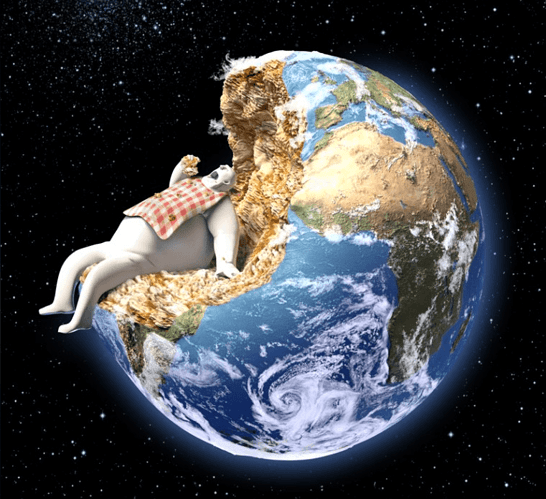For the Guardian, Robert Macfarlane writes about how artists and writers have envisioned the Anthropocene. He helpfully and clearly traces the origins of the term (apparently it was made up on the spot by atmospheric chemist Paul Crutzen at a conference in 1999), and introduces some key concepts buttressing the Anthropocene, such as Timothy Morton’s “Hyperobjects.” In partial below, the full version here.
Perhaps the greatest challenge posed to our imagination by the Anthropocene is its inhuman organisation as an event. If the Anthropocene can be said to “take place”, it does so across huge scales of space and vast spans of time, from nanometers to planets, and from picoseconds to aeons. It involves millions of different teleconnected agents, from methane molecules to rare earth metals to magnetic fields to smartphones to mosquitoes. Its energies are interactive, its properties emergent and its structures withdrawn.
In 2010 Timothy Morton adopted the term hyperobject to denote some of the characteristic entities of the Anthropocene. Hyperobjects are “so massively distributed in time, space and dimensionality” that they defy our perception, let alone our comprehension. Among the examples Morton gives of hyperobjects are climate change, mass species extinction and radioactive plutonium. “In one sense [hyperobjects] are abstractions,” he notes, “in another they are ferociously, catastrophically real.”
Creative non-fiction, and especially reportage, has adapted most quickly to this “distributed” aspect of the Anthropocene. Episodic in assembly and dispersed in geography, some outstanding recent non-fiction has proved able to map intricate patterns of environmental cause and effect, and in this way draw hyperobjects into at least partial visibility. Elizabeth Kolbert’s The Sixth Extinction: An Unnatural History (2014) and her Field Notes from a Catastrophe (2006) are landmarks here, as is Naomi Klein’s This Changes Everything: Capitalism vs the Climate (2014). In 2015 Gaia Vince published Adventures in the Anthropocene, perhaps the best book so far to trace the epoch’s impacts on the world’s poor, and the slow violence that climate change metes out to them.
Last year also saw the publication of The Mushroom at the End of the World: On the Possibility of Life in Capitalist Ruins, by the American anthropologist Anna Tsing. Tsing takes as her subject one of the “strangest commodity chains of our times”: that of the matsutake, supposedly the most valuable fungus in the world, which grows best in “human-disturbed forests”. Written in what she calls “a riot of short chapters, like the flushes of mushrooms that come up after rain”, Tsing’s book describes a contemporary “nature” that is hybrid and multiply interbound. Her ecosystems stretch from wood-wide webs of mycelia, through earthworms and pine roots, to logging trucks and hedge funds – as well as down into the flora of our own multispecies guts. Tsing’s account of nature thus overcomes what Jacques Rancière has called the “partition of the sensible”, by which he means the traditional division of matter into “life” and “not-life”. Like Skelton in his recent Beyond the Fell Wall (2015), and the poet Sean Borodale, Tsing is interested in a vibrant materialism that acknowledges the agency of stones, ores and atmospheres, as well as humans and other organisms.
